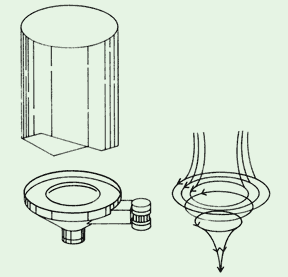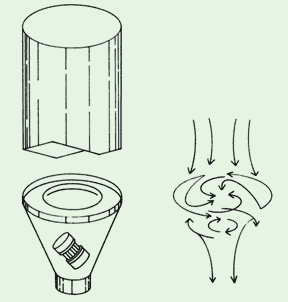Operation and construction
The bin activator should allow the stored product to flow optimally through its reasonably narrow nozzle.
Theoretically, material bridges should already be formed at the top of the bin activator, because the critical flow diameter was already exceeded when it was installed. Then no runoff would occur. However, the vibrating action of the bin activator transforms the flow properties.
Therefore, the bridges or top-holes are destroyed. Vibration acts in these phenomena by overloading, which means: vibration would be the equivalent of overloading any civil work (a bridge, for example) in such a way as to destroy it. This is exactly what the VICONE® vibrating discharge mouth does, but in two different applications, namely
Discharge of normal products
(light, medium or heavy)
For these products, the vibrating action must be elliptical, in the direction of the cross section plane of the vibrating mouth. This was experimentally proven, which also made it possible to study the discharge lines. These lines are schematized in the figure beside, following the schematic of the vibrating mouth with a drive.
The vibration-causing drive has the following characteristics: Three-phase asynchronous electric motor with short-circuited, unventilated rotor and vibration-proof coil; IP-55 protection and insulation class B. Adjustable unbalanced masses (counter weights) are fixed on the rotor ends, which cause the vibration when rotating. The masses are protected by steel covers; the bearings' bearings are made of special cast iron; the bearings are of the tapered roller type that are kept in their clearance by automatic adjustment.
Lubrication is done with high-drip point grease. More details can be found in the VIMOT® Vibrators brochure.
Unloading of light, normal and heavy products with a tendency to mutual blockage
Many products with bulk density between 0.01 and 2.5 t/m³ cannot be discharged with vibratory inlets of the type described above. In many cases they are fibrous or flocculent, interlacing easily (for example: matches, asbestos fiber, coarse sawdust, cut tobacco, etc.)
This interlacing can be undone with the application of vibratory inlets of the VICONE D® type, ensuring proper operation.
The basic difference consists of applying the vibration in a helical direction. For this, observe the figure at the side in which the discharge lines and the type of positioning of the vibratory drive are schematized. In this case the drive is double and acts in diametrically opposite positions at an angle of 45°.
Principles of dynamics, which need not be explained here, permit the synchronization of the two VIMOT® vibratory motors when they rotate in the same direction. This causes the helical flow and the unlocking of the material.
Conclusion
For medium to heavy products without jamming conditions, the VICONE S® type applies. In other cases VICONE D®, the latter with double drive.
It is important to note the presence of the internal cap (pressure distribution cone) in both systems. These hats are essential in vibratory inlets because they allow the relief of internal pressures and the transmission of vibrations to the storage silo.

